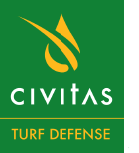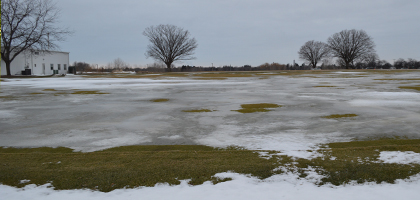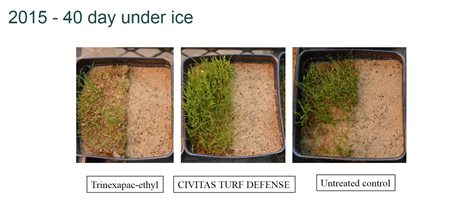


The massive ice storm of 2013 in Michigan and its devastating fallout across surrounding states set researcher Emily Merewitz, Ph.D., graduate student Kevin Laskowski and their team on a path to discover how Superintendents can better protect their turf moving into winter and even improve it come spring.
Kevin Laskowski from Plant, Soil and Microbial Sciences at Michigan State University, shared his drive, research and results at a recent GIS luncheon hosted by Intelligro. Here, attendees got the inside scoop on CIVITAS TURF DEFENSE™ and plant growth regulator effects on winter stress tolerance of annual bluegrass putting greens.
The Research Lull
Laskowski kicked off his talk with a reminder as to why we’ve seen such little research in this area since the 1960s. Quite simply – it’s hard.
Previous studies have uncovered the ‘why’ of ice damage. Ice, especially impermeable ice, reduces oxygen available to the plant. This compromises its ability to convert carbohydrates into energy that is then used to grow and create or maintain roots. In addition, ice cover can result in a buildup of harmful gases that impact the plant’s respiration and cause severe damage.
Current Management Practices
There are steps outside of chemical treatment that can be taken to manage ice and snow. However, they are largely dependent on available labor and budget and could pose a risk of further damage.
Making Ice Research a Priority Again
New products, new management strategies, extreme weather conditions and the debilitating and costly effects of ice and snow damage have all served as a jumping-off point for Laskowski. A survey was conducted including 80 superintendents across Michigan, neighboring states and Canada in an effort to gauge the impact and determine whether or not there were certain management practices associated with more or less ice damage.
Survey highlights:
The Study (2014-2015)
Merewitz and team used the information collected from the survey as well as course walks to create and test the following hypothesis: PGRs or other chemical treatments, such as plant defense activating treatments including CIVITAS TURF DEFENSE™, could alter turf growth habits and affect turfgrass crown membrane fatty acid ratios under winter stress.
Five different treatments including CIVITAS TURF DEFENSE™, Mefluidide, Propiconazole, Trinexapac-ethyl and untreated control plot were evaluated before and after winter to ensure they would not negatively affect turf performance in the fall or spring.
Label recommended rates were applied in 2014 and 2015 from July 31 to October 9 and August 5 to October 14, respectively. Each year, turf naturally acclimated outdoors before plugs were pulled and housed in growth chambers that replicated both low-temperature and average light levels for the winter months. The plugs were then subjected to 0 days of ice, 20 days of ice, 40 days of ice and 60 days of ice – after which they were transferred to a greenhouse to recover for 21 days.
Additionally, Laskowski noted that the chamber creates an extremely stressful environment. The entire pot is frozen, whereas in the field the soil would stay thawed. Any difference in survival would be classified as impressive due to the harsh controlled conditions.
The Results
The conclusions drawn from the fall fieldwork stated that PGR and plant protectant treatments could be used for winter protection without sacrificing turf quality in the fall. The inconsistent ice coverage for both years made it difficult to comment on the winter ice cover, but there was not much of a negative effect on spring green-up with the exception of mefluidide, which delayed spring green-up by a few weeks.
CIVITAS TURF DEFENSE™, mefluidide and propiconazole all improved regrowth from ice conditions and to some extent improved regrowth after low-temperature conditions without ice. In terms of ice cover specifically, PGRs, and plant protection products such as CIVITAS TURF DEFENSE seem to be viable options for turf managers.
Laskowski saw this study as an opportunity to explore a more budget-friendly and simplistic approach to ice and snow damage. With the use of PGRs and plant protectants including CIVITAS TURF DEFENSE™, Superintendents are able to maintain their current IPM programs with perhaps a slight adjustment of an additional application or two.

A researcher’s work is never done as Laskowski alluded to during his presentation and more exploration is needed.
For more information on how CIVITAS TURF DEFENSE can help protect your turf, talk to one of our technical managers by contacting Matthew.Weaver@petrocanadalsp.com.